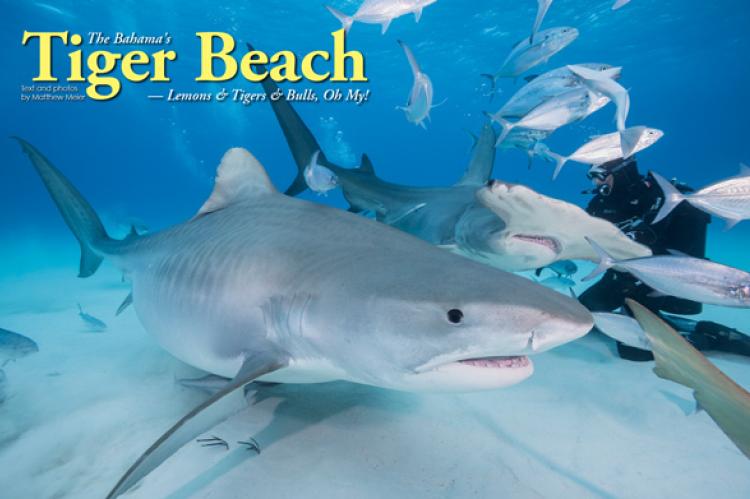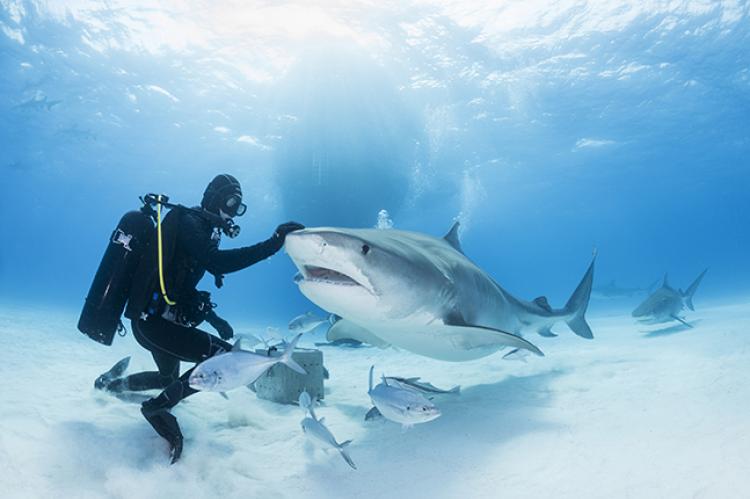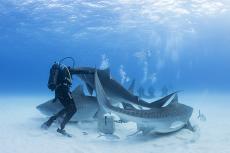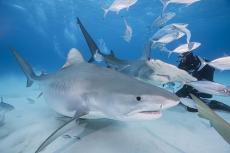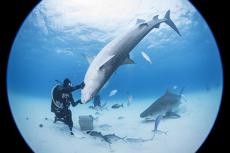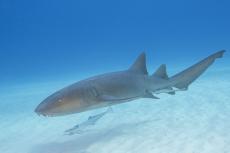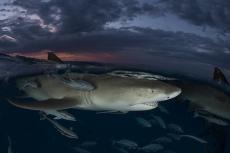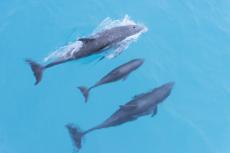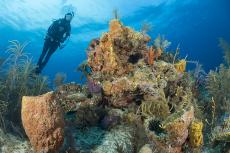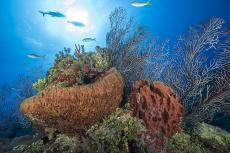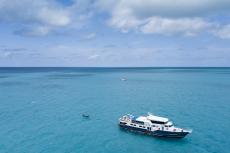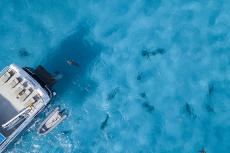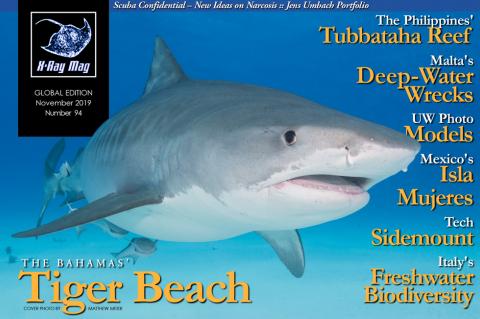The Bahamas' Tiger Beach
Standing on the swim step, trying to time my entry with a gap in the dozen or more lemon sharks circling directly below me was a bit daunting the first go around. Of course, the sharks knew this routine well and skillfully avoided my clumsy splash into the water. The reward waiting beneath the surface was an assemblage of sharks that cannot be collectively encountered anywhere else in the world.
A pregnant tiger shark is redirected by the feeder, while two more tiger sharks swim in the background, Tiger Beach, Bahamas. Photo by Matthew Meier.
As I settled onto the sandy bottom, a mere 20ft below the boat, a curious and very pregnant 13ft tiger shark came over to welcome me to her neighborhood. Soon a second, equally massive tiger shark appeared, then three bull sharks, several Caribbean reef sharks and a few lemon sharks followed along for good measure.
Finally, hovering only a few inches above the sand, a beautifully agile great hammerhead shark drifted past. It was just ten minutes into my checkout dive at Tiger Beach and I had already had close encounters with every shark I had hoped to see on this trip! My heart was pumping, my head was spinning and I could not even imagine how much more thrilling these encounters would become once the divemaster brought fish into the water and we began a proper tiger shark-feeding dive.
Getting there
Tiger Beach is a shallow sand flat located roughly 26 nautical miles from West End, Grand Bahama, and about equal distance from Fort Lauderdale in the US state of Florida. Divers have been interacting with sharks here for years, getting to this famous site via boats departing from both the United States and Grand Bahama Island. Day trips as well as multi-day liveaboard excursions are available from a range of operators, offering varying dive methods and creature comforts for their guests on board.
The Bahamas Master is the newest liveaboard in these waters and she began operations in February 2018, having previously catered to guests in the Pacific Ocean around Malpelo. Boats departing the United States have to cross the Gulf Stream, which can make for a rough journey, while boats from Grand Bahama depart from the towns of either West End or Freeport. The passage out of Freeport Harbour can only be made at high tide and thus dictates when the captain is able to begin the 93-mile trek to Tiger Beach. Several daily flights are available from both Fort Lauderdale and Miami, in the United States, to the Grand Bahama International Airport in Freeport. A ferry service is also available for those that prefer not to fly.
How it works
My seven-day liveaboard adventure provided nearly unlimited bottom time and unfettered access to the sharks. For the majority of our trip, our divemasters rotated in and out of the water throughout the day, allowing the guests to submerge at their discretion. We visited dive sites such as Classic Tiger and The Pool, with depths of approximately 30ft and 18 ft respectively. I averaged 90 to 120 minutes per tank and spent up to five hours a day underwater.
At such shallow depths, there is not much need for a surface interval between dives, and I would often come up for more air, a quick restroom break, a drink of water and a snack before dropping right back into the water. When immersed with the sharks, divers were over-weighted, so we sank and stayed on the bottom. Traversing from the downline off the back of the boat to the feeding location was done by walking backwards in fins across the sand, as the divemasters did not want us swimming up in the water column.
Each diver was outfitted, head to toe, in dark-colored wetsuits to help eliminate any confusion a bright, contrasting color might create for the sharks, and we were given an extensive safety briefing before our first dive. For our own protection, each diver was given a “patent-pending” 3ft section of PVC pipe to fend off the sharks. The pipe was meant to be placed vertically in the sand in front of an approaching shark so that the shark would change direction and not swim head on into a diver. Those of us with large dome ports on our underwater housings were instructed to redirect the sharks with our cameras, allowing for countless face-to-face meetings just prior to each shark being turned aside or guided up and over our heads.
Baited dives
These dives were so-called baited or feeding dives, in which the divemaster/feeder went down with a small, steel crate of fish to attract the sharks, and on occasion, would offer a tiger or great hammerhead shark a hand-fed snack. No fish was intentionally given to the bull or lemon sharks, nor the nurse or Caribbean reef sharks, which also made appearances.
On several stretches throughout the trip, we were able to observe all six shark species on a particular dive. Still, I was only ever able to capture five of the species in a single photo. Divers formed two lines upcurrent in a “V” formation, kneeling on either side of the feeder, allowing the sharks to follow the smell of fish and essentially swim down a runway past the divers to the bait.
Enough space was left to either side of the feeder to permit the sharks to pass between the divemaster and the first guest before circling around for another stroll down the runway. The gap between each subsequent diver was kept at an arm’s length to deter the sharks from swimming directly between the divers. When a shark followed this path, it was fairly easy to keep track of them, but there was almost always another shark coming from a different direction, requiring divers to keep their heads on a swivel and continually watch their backs.
All of the divers in the water worked in a collaborative system, pointing out each shark as they approached, to help give everyone an extra set of eyes on the backs of their heads. The intensity I thought I had experienced on my checkout dive was nothing compared to when six or eight tiger sharks were circling the group, and the top priority shifted from taking pictures to simply keeping the camera in-between myself and the nearest shark.
I was surprised at how sore I was at the end of the day from all of the twisting, turning, kneeling and lunging, which was required to keep an eye on my surroundings and maintain body position on the sand. Not to mention the mental exhaustion such an adrenalin-filled activity inflicts on one’s body.
Special attention must be given to the tiger and great hammerhead sharks, while remembering not to ignore the bull or lemon sharks. All can be inquisitive and will suddenly appear behind you if you are not paying attention. The bull sharks especially can be quite brazen as they venture out from beneath the boat while divers are walking to or from the feeding location. Yet, as soon as eye contact was made, they quickly turned to swim back to the safety of the shadows.
Topside
When not in the water, guests were able to relax in the comfy beanbag chairs in the lounge, work on their tans on the back deck or even observe the shark action from up above, while sharing stories from their latest shark encounter—whether that was watching the circling lemon sharks, swimming near the surface, or looking down at the dark shadows of the tiger sharks strutting their way down the runway.
Full meals were served three times daily, with multiple menu items offered to accommodate varying tastes and food restriction requirements. Snacks, sodas, juice, hot coffee or tea and water were always available, as were beer and wine after your dive day was finished.
Photography challenges
I spent a lot of my time in-between dives in the camera room swapping out batteries and memory cards throughout the day. The rapid-fire action down below meant that I shot a ton of photos and quickly wore out my strobe’s battery packs. The extensive access to the sharks also allowed me to test several lenses for differing perspectives and shot variety.
We enjoyed lovely sunrises and sunsets from the top deck and an incredible view of the night sky, with little to no light pollution so far out at sea. Several members of our group screened a different selection from the Jaws movies lineup each night, and there was always some sort of shark-related show on the television.
On two of the calmer nights while anchored at Tiger Beach, the divemasters attracted lemon sharks to the back deck for photo opportunities. Conditions were not ideal for sunset split shots, as we had sizeable waves at times, but I managed a couple of lucky photos in spite of being bounced around while laying on the swim step.
Known shark groups and individuals
The crew characterized the tiger sharks that visited us each day as belonging to one of three groups. The "Supermodels" were the most comfortable with the divers and would loop down the runway time and again, even when they were the only sharks in the area. The "Players" were familiar with the routine but would more readily saunter down the runway only if other sharks were present. “Wild sharks” were skittish and would show up on occasion, attracted by the fish, but they stayed on the periphery and infrequently ventured towards the feeder, rarely getting close to the divers.
Many of the Supermodels and Players have been regular visitors over the years and are known by such names as Emma, Tequila, Maui, Maria, Frankie, Freckles and Jitterbug. In total, we saw 10 to 12 different tiger sharks during our expedition, including a couple of unnamed, new faces and one 8ft juvenile that made two brave, relatively close passes on our very last dive.
Nearly all of the tiger sharks that frequent this area are female. A large number of the ones we encountered were pregnant, and the sharks can be found here almost year round. For the past three years, a great hammerhead shark named “Patches” has taken up residency and another, even larger hammerhead named “Queen” has made frequent appearances. Unfortunately, we were not lucky enough to see her on our visit.
Patches was the first great hammerhead to migrate over from Bimini and not return. At 12 to 14ft long, she is an imposing figure, with numerous spots on her underside, for which she is named. The spots darken in color throughout the year as the melatonin in Patches’ skin tans from the reflected sunlight off the sand.
Location & conditions
Tiger Beach sits just east of the deep water Gulf Stream and offers little protection from the wind and waves that Mother Nature can generate over the open ocean. Storms and winds from the west can stir up the sand in the shallows with strong waves and swell, reducing visibility and ultimately creating conditions that are not conducive to diving with the sharks.
On those nights when the wind was churning up the sea, our captain ventured farther east of Tiger Beach to anchor and find calmer sleeping conditions. For part of two days during our trip, we were unable to dive with the sharks, but this did not always keep us out of the water entirely. It actually provided us with the opportunity to expand our diving diversity with some reef dives.
There are beautiful, pristine coral reefs, with deep ledges and drop-offs, only a few minutes to the west of Tiger Beach, where the visibility is much less affected by the waves. As long as it is safe to enter and exit off the back of the boat, it is possible to dive the reefs and enjoy a colorful break from the sandy desert.
There are vibrant sea fans, large barrel sponges, beautiful hard and soft corals, several species of grouper, crabs, lobster, schooling reef fish and of course sharks. These were some of the healthiest reefs I have seen in the Bahamas, or even the Caribbean for that matter.
On occasion, the tiger sharks will follow the boat away from the beach, where you can encounter them in a free-swimming environment. Caribbean reef sharks, nurse sharks, bull sharks and lemon sharks can also be found swimming over the reef.
More dives with sharks
The last two days of our trip were near polar opposites as far as wind, waves, visibility and action. We started the second to last day with two dives on the nearby reefs in hopes that the wind would subside and conditions would improve underwater for the sharks.
By midday, we were anchored back at The Pool but the swell was still stirring up the sand and we consequently waited a few more hours before reassessing the situation. The decision was made later in the day to reestablish shark feeding activities and I hopped in the water for most of the next three hours.
The first two hours proved to be an exercise in Zen breathing techniques, as there was little to do at times but stare at the sand. We had a few Caribbean reef sharks, bull sharks and lemon sharks slowly circle the group, but their presence was often short-lived.
By the time I exited the water to refill my tank, our group had dwindled to the point that there was only one other person still in the water with the feeder. After my airfill, I stayed near the surface at the back of the boat in an attempt to photograph the lemon sharks up in the water column before seeing our first tiger shark of the day approach down below.
Freckles had showed up to pay us a visit and the three of us remaining in the water had her all to ourselves for the next 40 minutes. It was an incredibly peaceful afternoon that made us all appreciate the sheer number of sharks we had been diving with throughout the week.
Our last morning started a bit earlier than previous days, in hopes we could attract more of the sharks to our position and to give ourselves more time in the water before heading for home. The sun was shining, the wind had calmed, and everyone was excited for our last opportunity to get in the water with the sharks.
The early wake-up call seemed to pay off as we had six to eight tiger sharks (plus Patches), swimming amongst us for the next four hours, with beautiful light rays streaming in from above and clear, blue water all around. It was a magical, storybook ending to an extraordinarily memorable experience. I highly recommend this bucket-list, trip-of-a-lifetime-type adventure for anyone interested in a heart-pumping, intimate encounter with these magnificent apex predators. ■
The author would like to thank Master Liveaboards and the crew of the Bahamas Master (masterliveaboards.com/bahamas) for hosting this expedition as well as Scubapro (scubapro.com) and Blue Abyss Photo (blueabyssphoto.com) for their assistance with underwater dive and photo gear.
Matthew Meier is a professional underwater photographer and travel writer based in San Diego, California. To see more of his work and to order photo prints, please visit: matthewmeierphoto.com.
Download the full article ⬇︎
